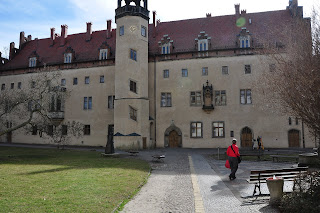There was a worship service on Saturday afternoon that they call “Motetten.” The choir was the Kammerkor Freiburg, and the setting for the service was an acappella passion (based on Luke) by an early 20th century composer, Rudolf Mauersberger. The choir was superb. The passion followed the style of Bach’s, with traditional chorales throughout, some of which the congregation also sang. And it was all acappella. It was wonderful to be in that building singing those chorales. And the first thing was the Thomaskirche organist playing Bach’s chorale prelude O Mensch, Bewein' dein' Sunde Gross, BWV 622 (O Man Bewail Thy Grievous Sin), which has always been a favorite of mine. There was a brief sermon, none of which we could understand, but it clearly matched the text, context, and mood. And we were sitting in north facing pews in the nave, and the windows clearest in our vision were those commemorating Bach and Luther. It was the perfect way to experience the place and I am very thankful for it.
Larry took lots of pictures before and after, and here’s one of the chancel and Bach’s grave:
 After the service we went across the street to the very excellent Bachhaus Museum. It is really a superb place. We wandered around with a gezillion other people, and finally had dinner at one of hte first Leipzig coffee places with lots of history, which we actually didn’t tumble to until the next day! We just picked it because the menu looked good. And indeed the food was very good!
After the service we went across the street to the very excellent Bachhaus Museum. It is really a superb place. We wandered around with a gezillion other people, and finally had dinner at one of hte first Leipzig coffee places with lots of history, which we actually didn’t tumble to until the next day! We just picked it because the menu looked good. And indeed the food was very good!The next morning we were a but confused about the time. England had changed to summer time on the first Sunday in March, and we blithely assumed that the rest of Europe had as well. Not so! Everyone else changed on the last Sunday in March. We finally got it all straight! We had already decided that we wouldn’t try to go to church, and it’s a good thing we did! I don’t think we would have made it. The breakfast at our hotel was splendid (love these German breakfasts) and we enjoyed it very much. We headed out to see more of Leipzig. We especially enjoyed seeing the Nikolaikirche, where Bach also played for festivals and other times. But the Nikolaikirche is noted now for being the place where what the call the “Quiet Revolution” began in 1989. People started gathering for prayer there on Monday nights, and out of that grew the movement that led to the fall of the GDR and the Berlin Wall. There is a very wonderful piece (in English!) about all of that on the Nikolaikirche’s website: http://www.nikolaikirche-leipzig.de/englisch-topmenu-100. It's the first thing - Events of 1989.
After seeing more of Leipzig (which is completely shut down on Sundays), we went Bach to our hotel for a quiet evening and a very good dinner in the restaurant there. We enjoyed Leipzig, and it was wonderful to be in that place where J. S. Bach was. He’s a very big deal there, and here is a picture of his statue outside the Thomaskirche. The fading flowers below were place there on his birthday on 21 March.
























